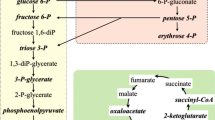Abstract
Historical analyses of what metabolism has been conceived of, how concepts of metabolism were related to disciplines such as nineteenth-century nutritional physiology or twentieth-century biochemistry, and how their genealogies relate to the current developments may be helpful to understand the various, at times polemic, ways in which the boundaries between metabolism and heredity have been re-drawn. Against this background, a small number of scholars gathered in Berlin for a workshop that equally aimed at bringing new stories to the fore, and at considering seemingly known ones in a new light. Some aspects of the discussions are summarized in this paper.
Similar content being viewed by others
Notes
Landecker (2013b) discusses the shifting boundaries between metabolism and reproduction in the history of the life sciences. It is interesting to note that metabolism was quite visible in the historiography of the life sciences until the early 1990s, such as in the works of Robert Kohler (1975) or Frederic Holmes on biochemistry (e.g. Holmes 1992). After that, molecular genetics progressively moved into the focus of attention.
See the forthcoming book: K. Nickelsen (2015). Explaining Photosynthesis. Modelling Biochemical Mechanisms 1840–1960. Dordrecht: Springer.
In 1952, microbiologist C.B. van Niel, one of Kluyver’s former assistants argued that “the enormous clarification brought about by the enunciation of the ‘unitarian approach’ […] has become so much a part of our thinking that the very fact of its once having been started is no longer taken into account.” (van Niel 1953, p. 11).
Elizabeth Neswald (2011) has argued for the central role of the necessary interaction and cooperation between experimenters and animals in nineteenth-century nutrition experiments. Since the workshop papers focused on bacteria, plants, and chemical engineering, this issue perhaps did not arise, but it should be important for a broader perspective on metabolism that includes research on humans and animals.
In this latter molecular biological, informational version, the ways organisms “make proteins” has become part of the history of molecular biology, as epitomized in the 1968 Nobel prize for the “genetic code” to Robert Holley, Har Gobind Khorana and Marshall Nirenberg. See Kay (2000) and Rheinberger (1997) for more details.
References
Bachelard, G. (1972). L’actualité de l’histoire des sciences. In G. Bachelard (Ed.), L’engagement rationaliste (pp. 137–152). Paris: Presses universitaires de France.
Brandt, C. (2004). Metapher und Experiment. Von der Virusforschung zum genetischen Code. Göttingen: Wallstein.
Creager, A. N. H. (2013). Life atomic: A history of radioisotopes in science and medicine. Chicago: University of Chicago Press.
de Lorenzo, V. (2014). From the selfish gene to selfish metabolism: Revisiting the central dogma. BioEssays, 36, 226–235.
Duchesneau, F. (2007). The delayed linkage of heredity with cell theory. In S. Müller-Wille & H.-J. Rheinberger (Eds.), Heredity produced: At the crossroads of biology, politics, and culture, 1500–1870 (pp. 293–314). Cambridge: MIT Press.
Holmes, F. L. (1992). Between biology and medicine: The formation of intermediary metabolism. Berkeley: University of California Office for the History of Science and Technology.
Holmes, F. L. (2001). Meselson, Stahl, and the Replication of DNA: A history of ‘the most beautiful experiment in biology’. New Haven: Yale University Press.
Kamminga, H., & Cunningham, A. (Eds.). (1995). The science and culture of nutrition, 1840–1940. Amsterdam: Rodopi.
Kay, L. E. (2000). Who Wrote the Book of Life? A history of the genetic code. Stanford: Stanford University Press.
Kluyver, A. J., & Donker, H. J. L. (1926). Die Einheit in der Biochemie. Chemie der Zelle und Gewebe: Zeitschrift für die Probleme der Gärung, Atmung und Vitaminforschung, 13, 134–139.
Kohler, R. E. (1975). The history of biochemistry: a survey. Journal of the History of Biology, 8(2), 275–318.
Landecker, H. (2011). Food as exposure: Nutritional epigenetics and the new metabolism. BioSocieties, 6, 167–194.
Landecker, H. (2012). The life of movement: from microcinematography to live-cell imaging. Journal of Visual Culture, 11, 378–399.
Landecker, H. (2013a). Post-industrial metabolism: Fat knowledge. Public Culture, 25(3), 495–522.
Landecker, H. (2013b). Metabolism, reproduction, and the aftermath of categories. Feminist & Scholar Online 11(3), online edition.
Morgan, N. (1990). The strategy of biological research programmes: Reassessing the ‘dark age’ of biochemistry, 1910–1930. Annals of Science, 47(2), 139–150.
Müller-Wille, S., & Rheinberger, H.-J. (2012). A cultural history of heredity. Chicago: University of Chicago Press.
Neswald, E. (2011). Eigenwillige Objekte und widerspenstige Dinge. Das Experimentieren mit Lebendigem in der Ernährungsphysiologie. In N. Adamowsky, R. Felfe, M. Formisano, G. Toepfer, & K. Wagner (Eds.), Affektive Dinge. Objektberührungen in Wissenschaft und Kunst (pp. 51–79). Göttingen: Wallstein.
O’Malley, M. A. (2014). Philosophy of microbiology. Cambridge: Cambridge University Press.
Ostwald, W. (1914). Die Welt der vernachlässigten Dimensionen. Eine Einführung in die Kolloidchemie. Dresden: Th. Steinkopff.
Parnes, O. (2003). From agents to cells. Theodor Schwann’s research notes of the years 1835–1838. In F. L. Holmes, J. Renn & H.-J. Rheinberger (Eds.), Reworking the bench: Research notebooks in the history of science (pp. 119–140). Dordrecht: Kluwer Academic Publishers.
Rasmussen, N. (1997). Picture control: The electron microscope and the transformation of biology in America, 1940–1960. Stanford: Stanford University Press.
Rheinberger, H.-J. (1997). Towards a history of epistemic things. Synthesizing proteins in the test tube. Stanford: Stanford University Press.
Schwann, Th. (1839). Mikroskopische Untersuchungen über die Übereinstimmung in der Struktur und dem Wachsthum der Thiere und Pflanzen. Berlin: Reimer.
van Niel, C. B. (1953). Introductory remarks on the comparative biochemistry of microorganisms. Journal of Cellular and Comparative Physiology, 41(1), 11–38.
Author information
Authors and Affiliations
Corresponding author
Rights and permissions
About this article
Cite this article
Grote, M., Keuck, L. Conference report “Stoffwechsel. Histories of metabolism”, workshop organized by Mathias Grote at Technische Universität Berlin, November 28–29th, 2014. HPLS 37, 210–218 (2015). https://doi.org/10.1007/s40656-015-0071-0
Received:
Accepted:
Published:
Issue Date:
DOI: https://doi.org/10.1007/s40656-015-0071-0




